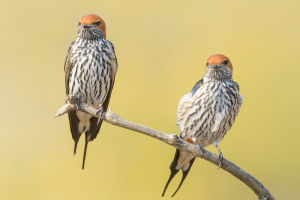The Majestic Greater Kudu
The Greater Kudu (Tragelaphus strepsiceros) is one of Africa’s most majestic and distinguished antelopes, renowned for its striking spiral horns and graceful physique.
Found across the woodlands and savannas of eastern and southern Africa, these antelopes are a true embodiment of elegance and resilience in the wild.
Distinctive Features
One of the most captivating features of the Greater Kudu is the impressive, corkscrew-shaped horns possessed by males. These horns can spiral up to three full turns, reaching lengths of up to 72 inches (about 1.8 meters). The horns are not just ornamental but play a significant role in dominance displays and defense. Females, on the other hand, do not have horns but share the species' signature sleek and streamlined body shape.
The Greater Kudu’s coat is a soft, grayish-brown color adorned with 6 to 10 vertical white stripes that run along its flanks, helping it blend seamlessly into its surroundings. A distinct white chevron marking graces the forehead between the eyes, and large, sensitive ears help detect the slightest sounds, aiding in predator evasion. Adult males also develop a beard-like fringe along their throats and a pronounced hump over their shoulders, adding to their regal appearance.
Behavior and Diet
Greater Kudus are browsers, primarily feeding on leaves, twigs, fruits, and flowers. They favor vegetation that provides high nutritional value, and their feeding habits change with the seasons. During the dry season, they rely on moisture-rich foliage to stay hydrated, while in the wet season, they feast on a wider variety of lush plant material. Their foraging patterns contribute significantly to the ecosystem by promoting plant growth and seed dispersal.
Survival and Predators
Living in the wild comes with constant threats, and Greater Kudus must stay vigilant. Their primary predators include lions, leopards, cheetahs, wild dogs, and hyenas. Kudus rely on their excellent hearing and camouflage for survival. If they sense danger, they often freeze to blend into the bush, but when necessary, they can sprint away in long, graceful leaps that make them difficult targets.
Conservation Status
The Greater Kudu is currently listed as “Least Concern” by the International Union for Conservation of Nature (IUCN). However, localized threats continue to pose risks to certain populations. Conservation efforts, including anti-poaching measures and habitat preservation, are essential to maintain stable populations and ensure these antelopes continue to thrive in the wild.
Cultural Significance
In various African cultures, the Greater Kudu holds symbolic importance. The spiral horns are often used in traditional ceremonies and as musical instruments, known as kudu horns. The animal’s majestic presence and beauty have also made it a popular subject in African folklore and art.
Lykkers, The Greater Kudu, with its elegance and strength, remains a remarkable part of Africa’s diverse wildlife, inspiring awe and admiration among those who witness its beauty. Conservation initiatives are crucial to preserving this iconic species and the rich biodiversity of the African landscapes it inhabits.
Greater Kudu (Tragelaphus strepsiceros) Animal Call | Kudu Bark | Stories Of The Kruger
Video by Stories Of The Kruger

